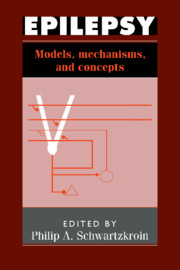Book contents
- Frontmatter
- Contents
- List of contributors
- General introduction
- Section 1 Chronic models in intact animals – concepts and questions
- Section 2 Features of the epileptogenic brain
- Introduction
- 6 Neurophysiological studies of alterations in seizure susceptibility during brain development
- 7 Electrophysiology and pharmacology of human neocortex and hippocampus in vitro
- 8 Cell death, plasticity, and epilepsy: insights provided by experimental models of hippocampal sclerosis
- 9 Sprouting as an underlying cause of hyperexcitability in experimental models and in the human epileptic temporal lobe
- 10 Rapidly recurring seizures and status epilepticus: ictal density as a factor in epileptogenesis
- Section 3 ‘Normal’ brain mechanisms that support epileptiform activities
- Recent advances
- Index
10 - Rapidly recurring seizures and status epilepticus: ictal density as a factor in epileptogenesis
from Section 2 - Features of the epileptogenic brain
Published online by Cambridge University Press: 03 May 2010
- Frontmatter
- Contents
- List of contributors
- General introduction
- Section 1 Chronic models in intact animals – concepts and questions
- Section 2 Features of the epileptogenic brain
- Introduction
- 6 Neurophysiological studies of alterations in seizure susceptibility during brain development
- 7 Electrophysiology and pharmacology of human neocortex and hippocampus in vitro
- 8 Cell death, plasticity, and epilepsy: insights provided by experimental models of hippocampal sclerosis
- 9 Sprouting as an underlying cause of hyperexcitability in experimental models and in the human epileptic temporal lobe
- 10 Rapidly recurring seizures and status epilepticus: ictal density as a factor in epileptogenesis
- Section 3 ‘Normal’ brain mechanisms that support epileptiform activities
- Recent advances
- Index
Summary
Introduction
The frequency with which seizures occur has received little attention as a factor in epileptogenesis. As a result, there is sparse information relating to the question of whether widely spaced seizures and status epilepticus activate the same pathophysiological processes or whether each is associated with its own particular set of events; it is also not known whether seizures and status epilepticus lead to the same acute and chronic sequelae. In addition, events involved in the progression from isolated seizures to status epilepticus have not been identified.
Over the past several years our laboratory has examined these questions. In order to have precise control over the site of origin and timing of seizures we have used electrical stimulation through electrodes stereotactically positioned in the hippocampal formation of rats. Our work has revealed that small differences in the timing of seizure recurrence can give rise to different sorts of epileptic response. As a consequence various models of epilepsy have emerged. Each is suited to investigate the questions germane to its own particular kind of epileptic condition. However, by comparing results among the models, a number of other broader issues can be explored. Much of our work has utilized awake animals, but we have also extended the models to rats anesthetized with urethane. This extension allows certain studies that are difficult or impossible to perform in the awake rat.
- Type
- Chapter
- Information
- EpilepsyModels, Mechanisms and Concepts, pp. 323 - 356Publisher: Cambridge University PressPrint publication year: 1993
- 1
- Cited by

